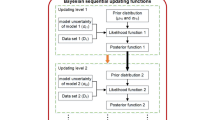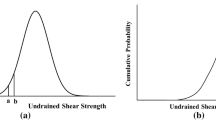Abstract
Slope stability analysis is an enduring research topic in the engineering and academic sectors. Accurate prediction of the factor of safety (FOS) of slopes, their stability and their performance is not an easy task. The current study aims at predicting the FOS on the geometrical and geotechnical input parameters [unit weight (γ), cohesion (C), slope angle (β), height (H), angle of internal friction (φ) and pore pressure ratio (ru)]. The Markov chain Monte Carlo (MCMC) methods have become a ubiquitous tool in Bayesian analysis. This paper implements MCMC methods for Bayesian analysis of models using the WinBUGS package, freely available software. The WinBUGS software is implemented to identify the most appropriate models for estimating the FOS among twenty (20) candidate models that have been proposed. The models were applied to available data given in open source literature. The unknown parameters of the models are considered as random variables. The WinBUGS software which uses Bayesian analysis of complex statistical models and MCMC techniques is employed to compute the posterior predictive distributions. The mean values of the model parameters obtained via MCMC simulations are considered for the model prediction performance evaluation. The performances of the proposed predictive models were examined according to two performance indices, i.e., coefficient of determination (R2) and mean square error. Overall, the results indicate that the proposed FOS model possesses satisfactory predictive performance.




Similar content being viewed by others
References
Adoko AC, Gokceoglu C, Yagiz S (2017) Bayesian prediction of TBM penetration rate in rock mass. Eng Geol 226:245–256
Babanouri N, Sarfarazi V (2018) Numerical analysis of a complex slope instability: pseudo-wedge failure. Geomech Eng 15:669–676
Bhandari T, Hamad F, Moormann C, Sharma KG, Westrich B (2016) Numerical modelling of seismic slope failure using MPM. Comput Geotech 75:126–134. https://doi.org/10.1016/j.compgeo.2016.01.017
Brooks S, Gelman A, Jones G, Meng X-L (2011) Handbook of markov chain monte carlo. CRC Press, Boca Raton
Cao Z-J, Wang Y, Li D-Q (2016) Site-specific characterization of soil properties using multiple measurements from different test procedures at different locations—a Bayesian sequential updating approach. Eng Geol 211:150–161
Cashen LH, Geiger SW (2004) Statistical power and the testing of null hypotheses: a review of contemporary management research and recommendations for future studies. Organ Res Methods 7:151–167
Cheng Y, Lansivaara T, Wei W (2007a) Two-dimensional slope stability analysis by limit equilibrium and strength reduction methods. Comput Geotech 34:137–150
Cheng Y, Li L, Chi S-C, Wei W (2007b) Particle swarm optimization algorithm for the location of the critical non-circular failure surface in two-dimensional slope stability analysis. Comput Geotech 34:92–103
Chiu C, Yan W, Yuen K-V (2012) Reliability analysis of soil–water characteristics curve and its application to slope stability analysis. Eng Geol 135:83–91
Chun YH (2008) Bayesian analysis of the sequential inspection plan via the Gibbs sampler. Oper Res 56:235–246
Duncan JM (1996) State of the art: limit equilibrium and finite-element analysis of slopes. J Geotech Eng 122:577–596
Ercanoglu M, Gokceoglu C (2002) Assessment of landslide susceptibility for a landslide-prone area (north of Yenice, NW Turkey) by fuzzy approach. Environ Geol 41:720–730
Fattahi H (2017) Prediction of slope stability using adaptive neuro-fuzzy inference system based on clustering methods. J Min Environ 8:163–177
Fattahi H, Zandy Ilghani N (2019a) Applying Bayesian models to forecast rock mass modulus. Geotech Geol Eng 37:4337–4349
Fattahi H, Zandy Ilghani N (2019b) Bayesian prediction of rotational torque to operate horizontal drilling. J Min Environ 10:507–515
Fattahi H, Varmazyari Z, Babanouri N (2019) Feasibility of Monte Carlo simulation for predicting deformation modulus of rock mass. Tunn Undergr Space Technol 89:151–156
Gao W (2015) Stability analysis of rock slope based on an abstraction ant colony clustering algorithm. Environ Earth Sci 73:7969–7982
Gelisli K, Kaya T, Babacan AE (2015) Assessing the factor of safety using an artificial neural network: case studies on landslides in Giresun, Turkey. Environ Earth Sci 73:8639–8646
Gimenez O et al (2009) WinBUGS for population ecologists: Bayesian modeling using Markov Chain Monte Carlo methods. In: Modeling demographic processes in marked populations. Springer, pp 883–915
Griffiths D, Fenton GA (2004) Probabilistic slope stability analysis by finite elements. J Geotech Geoenviron 130:507–518
Griffiths D, Lane P (1999) Slope stability analysis by finite elements. Geotechnique 49:387–403
Gu T, Wang J, Fu X, Liu Y (2015) GIS and limit equilibrium in the assessment of regional slope stability and mapping of landslide susceptibility. Bull Eng Geol Environ 74:1105–1115. https://doi.org/10.1007/s10064-014-0689-2
Hastings WK (1970) Monte Carlo sampling methods using Markov chains and their applications. Biometrika 57:97–109
Herath HS (2018) Post-auditing and cost estimation applications: an illustration of MCMC simulation for bayesian regression analysis. Eng Econ 300:1–33
Hoang N-D, Pham A-D (2016) Hybrid artificial intelligence approach based on metaheuristic and machine learning for slope stability assessment: a multinational data analysis. Expert Syst Appl 46:60–68
Jiang Q, Qi Z, Wei W, Zhou C (2015) Stability assessment of a high rock slope by strength reduction finite element method. Bull Eng Geol Environ 74:1153–1162. https://doi.org/10.1007/s10064-014-0698-1
Kahatadeniya KS, Nanakorn P, Neaupane KM (2009) Determination of the critical failure surface for slope stability analysis using ant colony optimization. Eng Geol 108:133–141
Kang F, Xu Q, Li J (2016) Slope reliability analysis using surrogate models via new support vector machines with swarm intelligence. Appl Math Model 40:6105–6120
Kang F, Xu B, Li J, Zhao S (2017) Slope stability evaluation using Gaussian processes with various covariance functions. Appl Soft Comput 60:387–396
Kaya A (2017) Geotechnical assessment of a slope stability problem in the Citlakkale residential area (Giresun, NE Turkey). Bull Eng Geol Environ 76:875–889. https://doi.org/10.1007/s10064-016-0896-0
Koopialipoor M, Armaghani DJ, Hedayat A, Marto A, Gordan B (2019) Applying various hybrid intelligent systems to evaluate and predict slope stability under static and dynamic conditions. Soft Comput 23:5913–5929
Kruschke JK, Aguinis H, Joo H (2012) The time has come: Bayesian methods for data analysis in the organizational sciences. Organ Res Methods 15:722–752
Li Y, Zhou H, Dong Z, Zhu W, Li S, Wang S (2018) Numerical investigations on stability evaluation of a jointed rock slope during excavation using an optimized DDARF method. Geomech Eng 14:271–281
Lim K, Li AJ, Lyamin AV (2015) Three-dimensional slope stability assessment of two-layered undrained clay. Comput Geotech 70:1–17. https://doi.org/10.1016/j.compgeo.2015.07.011
Lu P, Rosenbaum M (2003) Artificial neural networks and grey systems for the prediction of slope stability. Nat Hazards 30:383–398
Lunn DJ, Thomas A, Best N, Spiegelhalter D (2000) WinBUGS—a Bayesian modelling framework: concepts, structure, and extensibility. Stat Comput 10:325–337
Luo N, Bathurst RJ, Javankhoshdel S (2016) Probabilistic stability analysis of simple reinforced slopes by finite element method. Comput Geotech 77:45–55
Madzic E (1988) Stability of unstable final slope in deep open iron mine. Landslides 1:455–458
Marrapu BM, Jakka RS (2017) Assessment of slope stability using multiple regression analysis. Geomech Eng 13:237–254
Martel SJ, Muller JR (2000) A two-dimensional boundary element method for calculating elastic gravitational stresses in slopes. Pure Appl Geophys 157:989–1007
McCombie P, Wilkinson P (2002) The use of the simple genetic algorithm in finding the critical factor of safety in slope stability analysis. Comput Geotech 29:699–714
Ntzoufras I (2011) Bayesian modeling using WinBUGS, vol 698. Wiley, Hoboken
Pradhan B (2010) Application of an advanced fuzzy logic model for landslide susceptibility analysis. Int J Comput Intel Syst 3:370–381
Qi C, Tang X (2018) Slope stability prediction using integrated metaheuristic and machine learning approaches: a comparative study. Comput Ind Eng 118:112–122
Qi C, Wu J, Liu J, Kanungo DP (2016) Assessment of complex rock slope stability at Xiari, southwestern China. Bull Eng Geol Environ 75:537–550. https://doi.org/10.1007/s10064-015-0763-4
Rukhaiyar S, Alam M, Samadhiya N (2018) A PSO–ANN hybrid model for predicting factor of safety of slope. Int J Geotech Eng 12:556–566
Saboya F Jr, da Glória Alves M, Dias Pinto W (2006) Assessment of failure susceptibility of soil slopes using fuzzy logic. Eng Geol 86:211–224
Sah N, Sheorey P, Upadhyaya L (1994) Maximum likelihood estimation of slope stability. Int J Rock Mech Min Sci 31:47–53
Sakellariou M, Ferentinou M (2005) A study of slope stability prediction using neural networks. Geotech Geol Eng 23:419–445
Salmi EF, Hosseinzadeh S (2015) Slope stability assessment using both empirical and numerical methods: a case study. Bull Eng Geol Environ 74:13–25. https://doi.org/10.1007/s10064-013-0565-5
Spiegelhalter DJ, Best NG, Carlin BP, Van Der Linde A (2002) Bayesian measures of model complexity and fit. J R Stat Soc Ser B (Stat Methodol) 64:583–639
Suman S, Khan S, Das S, Chand S (2016) Slope stability analysis using artificial intelligence techniques. Nat Hazards 84:727–748
Sun S, Sun H, Wang Y, Wei J, Liu J, Kanungo DP (2014) Effect of the combination characteristics of rock structural plane on the stability of a rock-mass slope. Bull Eng Geol Environ 73:987–995. https://doi.org/10.1007/s10064-014-0593-9
Tschuchnigg F, Schweiger HF, Sloan SW (2015) Slope stability analysis by means of finite element limit analysis and finite element strength reduction techniques. Part II: back analyses of a case history. Comput Geotech 70:178–189. https://doi.org/10.1016/j.compgeo.2015.07.019
Tun YW, Pedroso DM, Scheuermann A, Williams DJ (2016) Probabilistic reliability analysis of multiple slopes with genetic algorithms. Comput Geotech 77:68–76. https://doi.org/10.1016/j.compgeo.2016.04.006
Wang H, Xu W, Xu R (2005) Slope stability evaluation using back propagation neural networks. Eng Geol 80:302–315
Wang B, Vardon PJ, Hicks MA (2016) Investigation of retrogressive and progressive slope failure mechanisms using the material point method. Comput Geotech 78:88–98. https://doi.org/10.1016/j.compgeo.2016.04.016
Yang C, Tham L, Feng X-T, Wang Y, Lee P (2004) Two-stepped evolutionary algorithm and its application to stability analysis of slopes. J Comput Civ Eng 18:145–153
Yu H, Salgado R, Sloan S, Kim J (1998) Limit analysis versus limit equilibrium for slope stability. J Geotech Geoenviron 124:1–11
Zhou W-H, Yuen K-V, Tan F (2014) Estimation of soil–water characteristic curve and relative permeability for granular soils with different initial dry densities. Eng Geol 179:1–9
Zhu J, Yang X (2018) Probabilistic stability analysis of rock slopes with cracks. Geomech Eng 16:655–667
Zhu D, Lee C, Jiang H (2003) Generalised framework of limit equilibrium methods for slope stability analysis. Geotechnique 53:377–395
Zolfaghari AR, Heath AC, McCombie PF (2005) Simple genetic algorithm search for critical non-circular failure surface in slope stability analysis. Comput Geotech 32:139–152
Author information
Authors and Affiliations
Corresponding author
Additional information
Publisher's Note
Springer Nature remains neutral with regard to jurisdictional claims in published maps and institutional affiliations.
Rights and permissions
About this article
Cite this article
Fattahi, H., Zandy Ilghani, N. Slope Stability Analysis Using Bayesian Markov Chain Monte Carlo Method. Geotech Geol Eng 38, 2609–2618 (2020). https://doi.org/10.1007/s10706-019-01172-w
Received:
Accepted:
Published:
Issue Date:
DOI: https://doi.org/10.1007/s10706-019-01172-w




